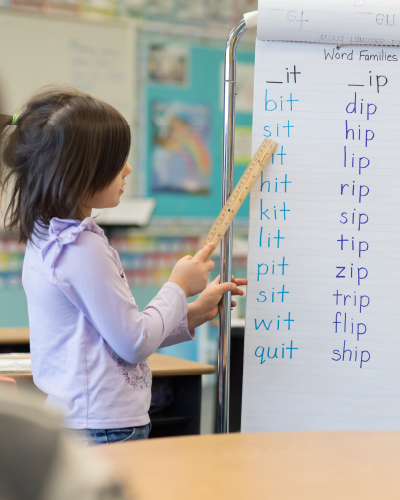The Colorado Department of Education's main phone line (303-866-6600) will be closed on Friday, February 7 from 8am until 1pm.
Lines will re-open at 1pm. For immediate assistance, contact cde_communications_office@cde.state.co.us.
You are here
Module 2 Activity Guide

Description
Understanding the unique articulatory features of English consonants and vowels can provide teachers with important instructional tools and insights into students’ errors so that appropriate, explicit corrections can be made. This activity provides an opportunity for teachers to engage with and classify each of the English phonemes to solidify their learning and better plan for instruction.
- Time: 20-30 Minutes
- Group Size: whole group (can also be done in small groups)
Materials Needed
- Poster Board or poster paper
- Markers
- Sticky Notes
Prepare in advance: Draw the chart for the place, manner, and voicing of English consonants onto poster board and label the columns and rows, ensuring space in each box for sticky notes to be placed (or enlarge and make into a poster). Prepare sticky notes with each of the consonant phonemes, as listed in the chart, but place them to the side of the poster for participants to manipulate.

Activity:
- Place the posterboard and sticky notes, so they are visible to all participants.
- Introduce a consonant phoneme and hold up the sticky note representing the phoneme (for example: /b/).
- Walk participants through identifying the features of the phoneme:
- Where and how is the phoneme produced in the mouth? (place of articulation)
- What do we do with our breath? Are our vocal cords engaged or not? (Manner of articulation)
- Ask a participant to place the sticky note in the correct location in the chart.
- Continue until all consonant phonemes have been properly placed.
- Debrief: How easy or difficult was this activity? How can this knowledge impact your instruction?
Description
The Four Part Processing Model for Word Recognition by Seidenberg and McClelland (1989) uses the evidence base to explain how the brain processes words at the phonological, orthographic, semantic, and syntactic levels. This activity reviews the structure of the theoretical model and the work of each processor in word recognition.
- Time: 15 minutes
- Group size: individual or pairs
Materials Needed
- Student writing samples or results of an administered spelling inventory
- Copies of English consonant and vowel charts (optional, for reference)
- Paper, pens, highlighters
Activity:
- Ask participants to analyze the student writing samples or spelling inventory for misspellings. Highlight each misspelled word or list on a separate piece of paper.
- Review each error individually or with a partner using these guiding questions:
- Is each of the phonemes in the word represented by a grapheme?
- If not, what is missing? (example: bk for bike is missing the medial vowel; jup for jump is missing the /m/ from the end blend)
- If each phoneme is represented by a grapheme, is the phoneme misrepresented? (for example, chrain for train? Or ‘sby’ for spy?)
- These types of spelling errors are typically phonological in nature and indicate that a student is either not processing individual phonemes or is hearing the allophonic variation of the phoneme caused by coarticulation.
- If each phoneme is represented by an appropriate grapheme (‘rane’ for rain), the error is orthographic and not a result of gaps in phonological knowledge. These types of errors can be addressed through targeted spelling instruction.
- Have participants analyze their overall data. Are there students who need continued support with processing individual phonemes in words? What instructional supports are needed? Which students need direct support with common allophonic variations that impact spelling? How about students whose errors are only orthographic in nature? What instructional moves would best support their continued development?
- Debrief: How does knowledge of phonology support more targeted instruction for students? How does analyzing student spelling errors in this way affect the way you plan for your students?
About the Review Activities' Guide:
The activities detailed in this guide were compiled to complement the training in scientifically and evidence-based reading instruction provided through the Colorado Department of Education by Public Consulting Group (PCG). Options for activities are intended to review content and strengthen learning from the modules in the training and are listed in the Facilitator Guide. Some activity options include links to resources needed for the individual activity. Each optional activity consists of a materials list, approximate time required and group size recommended, and steps to completing the activity with participants.



Connect With Us





